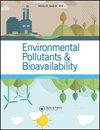三嗪染料活性蓝4在米根霉干细胞上的间歇吸附行为
Q3 Chemical Engineering
引用次数: 11
摘要
摘要研究了三嗪染料活性蓝4 (Reactive Blue 4)在干燥的米根霉(Rhizopus oryzae)生物质(ROB)上的吸附行为,并考察了吸附过程的理化参数。发现生物质对染料的吸附与溶液pH(最适为3.0)有关,而温度对染料的吸附无显著影响。在初始染料浓度为50和100 mg L−1和200 mg L−1时,生物质的吸附速率分别在5 h和6 h内达到平衡,符合准二级速率模型(R2 = 0.99)。平衡吸附等温线最适合用Redlich-Peterson模型来描述(R2 = 0.95)。扫描电镜显示,在染料吸附后,ROB的表面形貌发生了明显的变化。傅里叶变换红外光谱数据反映了活性蓝4通过涉及氨基和羧基的络合反应与生物质结合。活性蓝4可以用1(N) NaOH溶液从负载染料的生物质中解吸。结果表明,ROB具有涉及活性蓝4的污染控制管理潜力。本文章由计算机程序翻译,如有差异,请以英文原文为准。
Adsorption behavior of Reactive Blue 4, a tri-azine dye on dry cells of Rhizopus oryzae in a batch system
Abstract The adsorpion behavior of Reactive Blue 4, a tri-azine dye, on dry Rhizopus oryzae biomass (ROB) has been investigated in aqueous solution with special reference to physicochemical parameters associated with the adsorption process. Adsorption of dye on the biomass is found to be a function of solution pH (optimum 3.0), while temperature has no significant effect. Adsorption rate of biomass is very fast initially and attains equilibrium within 5 h for 50 and 100 mg L−1 and 6 h for 200 mg L−1 initial dye concentrations, respectively, following pseudo-second-order rate model (R2 = 0.99). The equilibrium adsorption isotherm can be best described by Redlich–Peterson model (R2 = 0.95). Scanning electron micrograph demonstrates a conspicuous change in surface morphology of ROB after dye adsorption. Fourier transform infrared spectroscopic data reflect the binding of Reactive Blue 4 on the biomass through complexation reaction involving amino and carboxyl groups. Reactive Blue 4 can be desorbed from the dye loaded biomass using 1(N) NaOH solution. Results establish that ROB has the potential to pollution control management involving Reactive Blue 4.
求助全文
通过发布文献求助,成功后即可免费获取论文全文。
去求助
来源期刊
CiteScore
1.62
自引率
0.00%
发文量
0
审稿时长
1 months
期刊介绍:
Chemical Speciation & Bioavailability ( CS&B) is a scholarly, peer-reviewed forum for insights on the chemical aspects of occurrence, distribution, transport, transformation, transfer, fate, and effects of substances in the environment and biota, and their impacts on the uptake of the substances by living organisms. Substances of interests include both beneficial and toxic ones, especially nutrients, heavy metals, persistent organic pollutants, and emerging contaminants, such as engineered nanomaterials, as well as pharmaceuticals and personal-care products as pollutants. It is the aim of this Journal to develop an international community of experienced colleagues to promote the research, discussion, review, and spread of information on chemical speciation and bioavailability, which is a topic of interest to researchers in many disciplines, including environmental, chemical, biological, food, medical, toxicology, and health sciences.
Key themes in the scope of the Journal include, but are not limited to, the following “6Ms”:
Methods for speciation analysis and the evaluation of bioavailability, especially the development, validation, and application of novel methods and techniques.
Media that sustain the processes of release, distribution, transformation, and transfer of chemical speciation; of particular interest are emerging contaminants, such as engineered nanomaterials, pharmaceuticals, and personal-care products.
Mobility of substance species in environment and biota, either spatially or temporally.
Matters that influence the chemical speciation and bioavailability, mainly environmentally relevant conditions.
Mechanisms that govern the transport, transformation, transfer, and fate of chemical speciation in the environment, and the biouptake of substances.
Models for the simulation of chemical speciation and bioavailability, and for the prediction of toxicity.
Chemical Speciation & Bioavailability is a fully open access journal. This means all submitted articles will, if accepted, be available for anyone to read, anywhere, at any time. immediately on publication. There are no charges for submission to this journal.

 求助内容:
求助内容: 应助结果提醒方式:
应助结果提醒方式:


